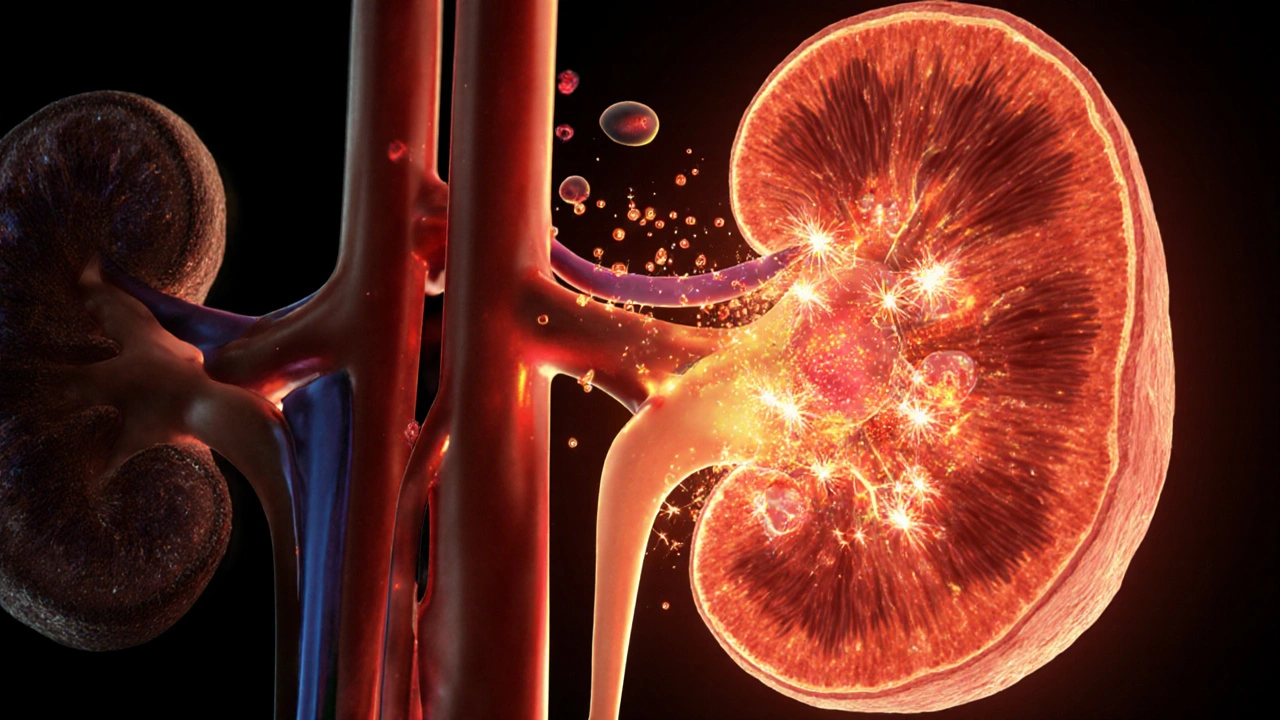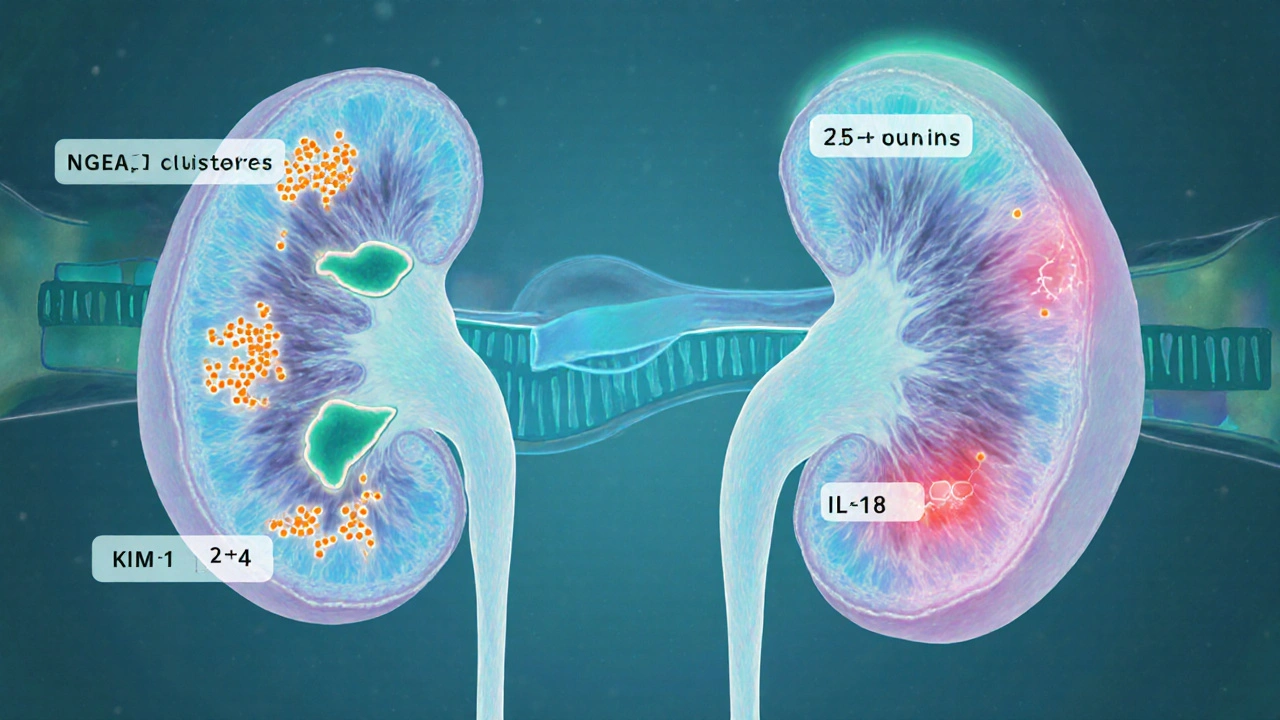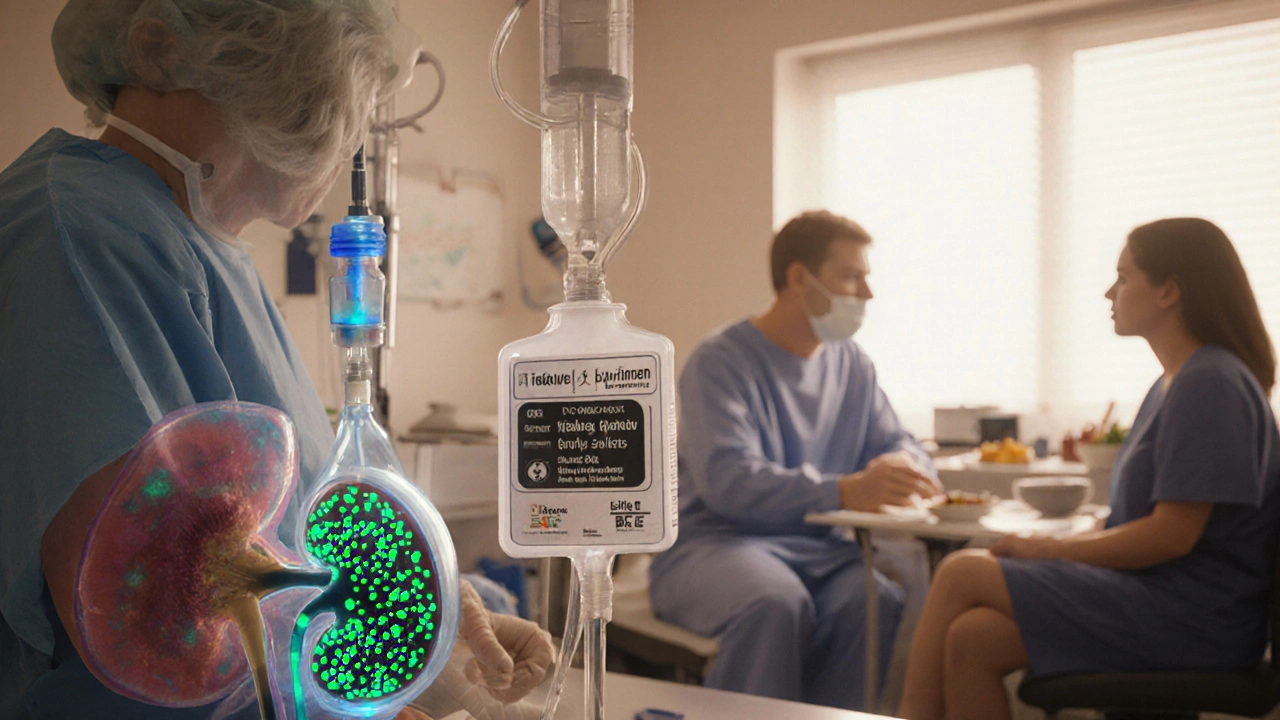Reperfusion Injury and Kidney Disease: Essential Facts and Management
 Oct, 5 2025
Oct, 5 2025
Reperfusion Injury Risk Calculator
Risk Assessment Results
Early Biomarkers to Monitor
| Biomarker | Time to Rise | Significance |
|---|
When blood flow returns to an organ after a period of blockage, the sudden rush of oxygen can paradoxically cause more damage than the original lack of blood. This paradox, called reperfusion injury, is a hidden danger for the kidneys and can turn a temporary problem into lasting kidney disease. Below you’ll find what drives the injury, how it shows up in the kidneys, and what you can do to prevent or treat it.
Key Takeaways
- Reperfusion injury occurs when oxygen‑rich blood re‑enters tissue after ischemia, sparking oxidative stress and inflammation.
- The kidneys are especially vulnerable because they receive 20% of cardiac output despite their small size.
- Acute kidney injury (AKI) is the most common immediate outcome; repeated episodes can accelerate chronic kidney disease (CKD).
- Early biomarkers such as NGAL and KIM‑1 help detect damage before creatinine rises.
- Therapies focus on antioxidant delivery, controlled reperfusion, and pre‑conditioning strategies.
What Is Reperfusion Injury?
Reperfusion injury is a cellular damage cascade that begins the moment blood flow returns to previously ischemic tissue. The sudden influx of oxygen creates reactive oxygen species (ROS), destabilizes cell membranes, and triggers an inflammatory response that can outpace the organ’s repair mechanisms.
Why the Kidneys Are a Soft Target
Kidney disease encompasses any condition that impairs the kidneys’ ability to filter waste, regulate fluid, and balance electrolytes. Because the kidneys filter roughly 180liters of blood each day, they experience a high oxygen demand and are exposed to large swings in perfusion pressure. When reperfusion occurs, the renal microvasculature faces a perfect storm of ROS, endothelial injury, and leukocyte adhesion.
Mechanisms That Link Reperfusion to Kidney Damage
Three interrelated pathways dominate the injury process:
- Oxidative stress: ROS such as superoxide and hydroxyl radicals oxidize lipids, proteins, and DNA. Oxidative stress overwhelms antioxidant defenses like glutathione and superoxide dismutase, leading to mitochondrial failure.
- Inflammation: Damaged cells release danger‑associated molecular patterns (DAMPs) that attract neutrophils and macrophages. Inflammation amplifies vascular leakage and creates a feedback loop of further ROS production.
- Mitochondrial dysfunction: The mitochondrial permeability transition pore opens, collapsing ATP production. Mitochondrial dysfunction triggers apoptosis and necrosis in tubular epithelial cells.
Kidney Disease Outcomes After Reperfusion
The injury can manifest in two major clinical syndromes:
- Acute kidney injury (AKI) - a rapid rise in serum creatinine or drop in urine output within hours to days after reperfusion. AKI is common after cardiac surgery, transplantation, or severe sepsis.
- Chronic kidney disease (CKD) - when repeated or unresolved AKI episodes cause scarring, loss of nephrons, and progressive decline in glomerular filtration rate (GFR) over months to years.

Early Warning Signs and Biomarkers
Relying on serum creatinine alone misses the early window. Modern research highlights several biomarkers that rise within 2-6hours of reperfusion:
| Biomarker | Peak time after reperfusion | Clinical relevance |
|---|---|---|
| NGAL (Neutrophil gelatinase‑associated lipocalin) | 2-4h | Early tubular injury; predicts need for dialysis |
| KIM‑1 (Kidney injury molecule‑1) | 4-8h | Reflects proximal tubule damage |
| IL‑18 | 6-12h | Inflammatory marker linked to worse outcomes |
| Serum creatinine | 24-48h | Traditional but late indicator |
Serial measurement helps clinicians decide whether to intensify supportive care or initiate renal replacement therapy.
Prevention Strategies: Controlling the Re‑entry
Because the injury starts the moment blood flows back, controlling that moment is crucial. The most studied tactics include:
- Ischemic pre‑conditioning: Brief, non‑lethal cycles of ischemia before a planned surgery prime antioxidant pathways. Human trials in cardiac bypass show a 30% reduction in AKI rates.
- Controlled reperfusion: Gradually restoring flow with a low‑pressure, low‑oxygen perfusate lessens ROS burst. Animal models suggest a 40% drop in tubular necrosis.
- Pharmacologic antioxidants: N‑acetylcysteine, vitamin C, and newer mitochondria‑targeted agents (MitoQ) scavenge ROS at the source. Meta‑analysis of 12 RCTs (2023) found a modest but statistically significant AKI risk reduction.
Treatment Options Once Injury Starts
When AKI has already set in, management focuses on limiting further damage and supporting recovery:
- Hemodynamic optimization: Maintaining mean arterial pressure >65mmHg and avoiding nephrotoxic drugs (e.g., high‑dose NSAIDs, contrast).
- Renal replacement therapy (RRT): Early initiation (within 12h of severe oliguria) can improve fluid balance and reduce uremic toxins, but evidence on mortality benefit is mixed.
- Targeted anti‑inflammatory agents: Trials of IL‑6 inhibitors and complement blockers are ongoing; early phase data show reduced biomarker spikes.
Long‑Term Care for Patients with Reperfusion‑Related Kidney Damage
Survivors of AKI should be followed for at least a year with serial eGFR checks, blood pressure monitoring, and lifestyle counseling. Key steps include:
- Adopt a low‑sodium, kidney‑friendly diet (≤2g sodium/day).
- Control diabetes and hypertension aggressively - target < 130/80mmHg for diabetics.
- Avoid repeat nephrotoxic exposures - use iso‑osmolar contrast when imaging is unavoidable.
- Consider enrollment in CKD prevention programs that offer education and medication titration.
Comparing AKI and CKD After Reperfusion Injury
| Feature | Acute Kidney Injury | Chronic Kidney Disease |
|---|---|---|
| Onset | Hours-Days | Months-Years |
| Primary biomarker rise | NGAL, KIM‑1 | eGFR decline, proteinuria |
| Reversibility | Possible with timely RRT | Progressive, usually irreversible |
| Risk of cardiovascular events | Elevated (≈20% within 30days) | High (≈50% over 5years) |
| Management focus | Hemodynamic support, toxin removal | Slowing progression, lifestyle |
Future Directions in Research
Scientists are exploring gene‑editing tools to boost endogenous antioxidant enzymes and nanocarriers that deliver protective drugs directly to renal mitochondria. By 2027, several phase‑III trials on mitochondrial‑targeted antioxidants are expected to report outcomes, potentially shifting standard of care.

Frequently Asked Questions
What exactly triggers reperfusion injury in the kidneys?
When oxygen‑rich blood floods a previously oxygen‑starved kidney, it generates a burst of reactive oxygen species, activates inflammatory pathways, and disrupts mitochondrial membranes. The combined effect damages tubular cells and the microvasculature.
How soon after surgery should I expect a rise in kidney injury biomarkers?
Markers like NGAL can rise within 2‑4hours, while KIM‑1 may appear around 4‑8hours. Traditional creatinine usually lags 24‑48hours, so early testing helps catch injury sooner.
Can I do anything before a planned operation to lower my risk?
Yes. Discuss ischemic pre‑conditioning protocols with your surgeon, ensure optimal blood pressure and hydration, and ask about antioxidant regimens such as N‑acetylcysteine.
Is dialysis always required after reperfusion‑related AKI?
Not always. Dialysis is reserved for severe electrolyte imbalance, volume overload, or refractory uremia. Many patients recover with supportive care and careful fluid management.
What lifestyle changes help prevent CKD after an AKI episode?
Maintain blood pressure < 130/80mmHg, keep blood sugar under control, limit sodium to 2g per day, stay well‑hydrated, and avoid unnecessary NSAIDs or contrast agents.

tierra hopkins
October 5, 2025 AT 02:46Great to see a tool that pushes clinicians to think about reperfusion injury before the surgery even starts. Early risk stratification lets us tweak fluids, hold nephrotoxic meds, and plan for tighter BP control – all of which can shave off a lot of morbidity. Keep the optimism up, but remember the calculator only guides, it doesn’t replace solid clinical judgment.
Ryan Walsh
October 12, 2025 AT 04:29Nice rundown. If you’re prepping for a case, just plug in the numbers and you’ll get a quick sense of who needs extra kidney protection. Simple as that.
Kiersten Denton
October 19, 2025 AT 06:12The risk calculator looks user‑friendly.
Karl Norton
October 26, 2025 AT 07:55Honestly, you can’t trust a web form to replace bedside assessment. These scores ignore nuances like hidden volume depletion or the subtle effects of anesthesia on renal perfusion. Over‑reliance on a numeric output may lull surgeons into a false sense of security. I’d rather see a thorough hemodynamic review than a checkbox.
lucy kindseth
November 2, 2025 AT 09:38When you dive into the pathophysiology of reperfusion injury, the first thing that hits you is the sheer cascade of reactive oxygen species that erupts the moment oxygenated blood re‑enters the ischemic kidney. Those free radicals slam into mitochondrial membranes, ripping open the electron transport chain and spilling out more toxic by‑products. Simultaneously, endothelial cells unleash adhesion molecules, recruiting neutrophils that further amplify the inflammatory milieu. The result is a perfect storm: tubular epithelial cells undergo necrosis, microvascular obstruction spikes, and the whole organ teeters on the edge of acute kidney injury. Clinically, this translates into a rapid rise in biomarkers like NGAL and KIM‑1 within hours, well before creatinine even thinks about moving. That early window is where we can intervene with targeted antioxidants, ischemic pre‑conditioning, or even novel complement inhibitors. Studies have shown that a timely bolus of N‑acetylcysteine can blunt the oxidative surge, though the data are still evolving. On the surgical side, meticulous control of perfusion pressure-keeping MAP above 65 mmHg-helps maintain adequate renal blood flow during the vulnerable phase. Avoiding high‑dose NSAIDs and contrast agents in the peri‑operative period removes two major nephrotoxic culprits. Fluid management is another cornerstone; a balanced crystalloids strategy prevents both hypovolemia and interstitial edema that can compress capillaries. If oliguria persists despite these measures, early consideration of renal replacement therapy can off‑load toxins and give the kidneys a breather. Long‑term, survivors need a structured follow‑up plan with serial eGFR checks, blood pressure targets, and lifestyle counseling. The ultimate goal isn’t just to survive the episode but to steer clear of the chronic trajectory that leads to end‑stage renal disease. Keeping an eye on proteinuria, adjusting ACE inhibitors, and encouraging a low‑sodium diet are all part of that preventive arsenal. In short, reperfusion injury is a multi‑hit phenomenon that demands a multi‑modal response, and the risk calculator is just the first step on that roadmap.
Nymia Jones
November 9, 2025 AT 11:21It must be noted, esteemed colleagues, that the pharmaceutical industry has vested interests in promoting antioxidant regimens that lack rigorous, peer‑reviewed validation. One should remain vigilant against covert marketing that masquerades as evidence‑based practice. The allure of proprietary “renal‑protective” compounds often eclipses the modest yet robust benefits of generic measures such as meticulous hydration and blood pressure optimization. Therefore, I implore the readership to scrutinize the source of any recommended adjunct and to prioritize interventions substantiated by randomized controlled trials.
Karen McCormack
November 16, 2025 AT 13:03Reperfusion injury, in its relentless return of life to a wounded organ, mirrors the paradox of revival that poets have long mused upon. The kidney, once starved, greets oxygen with both hope and havoc, a delicate dance of renewal and ruin. We, as caretakers, must learn to choreograph that dance, lest we stumble on the very thing we seek to heal. Thus, wisdom lies not merely in numbers, but in the humility to respect the organ’s fragile rebirth.